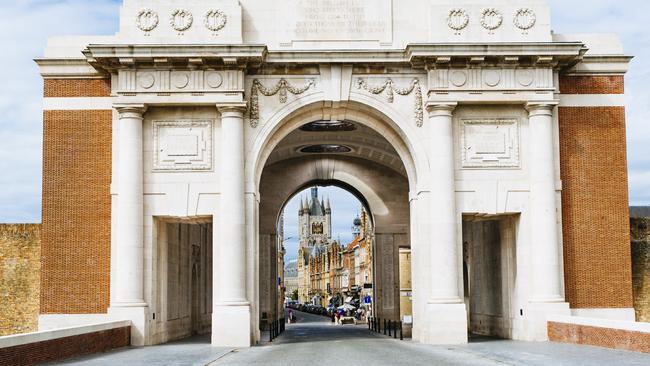A handmade wreath of wattle and gum leaves, wrapped with red and purple poppies, sits among thousands placed at the imposing Belgian memorial to honour 54,900 Allied soldiers killed on Flanders battlefields in World War I.
The wreath was laid during a Last Post ceremony at the Menin Gate by University of Newcastle students Annie McDonald, Jordan Kolarik, Mikahlia Holmes and Vivienne Hockridge.
The names of 6169 Australians are listed on the Menin Gate Memorial to the Missing in Ypres, known locally as Ieper, where for 90 years four buglers have played the Last Post in a solemn evening ceremony.
During World War I, when up to 20 bombs a minute pounded the city, the site was considered “the unhealthiest corner of Europe”.
The Australian Army Band will accompany a Last Post anniversary ceremony at 8pm on Thursday, to be attended by Australian Veterans’ Affairs Minister Darren Chester.
The memorial arch, designed by British architect Sir Reginald Blomfield for the Imperial Graves Commission, straddles a moat in medieval ramparts on the eastern edge of Ypres. During World War I, when up to 20 bombs a minute pounded the city, the site was considered “the unhealthiest corner of Europe”.
The Graves Commission budgeted £5 for each missing soldier for memorials, a total of £250,000, although it was proposed the pale limestone gate would cost £130,000.
The Menin Gate site was chosen because hundreds of thousands of men passed through on their way to battlefields east of Ypres.
The Third Battle of Ypres alone, from July 31 to November 10, 1917, inflicted 580,000 casualties, with 310,000 from Allied nations including 38,000 Australians.
The gate was unveiled on July 24, 1927, and in 1928 Ypres police commissioner Pierre Henri Van den Braembussche initiated a daily Last Post ceremony, recruiting buglers from members of the Ypres Fire Brigade.
The city council, along with 70 or so spectators, attended the first Last Post ceremony on Monday, July 2, 1928 at 8.30pm.
The Third Battle of Ypres alone, from July 31 to November 10, 1917, inflicted 580,000 casualties, with 310,000 from Allied nations including 38,000 Australians
After a break during the winter, the ceremony resumed on May 1, 1929. Broken only by German occupation during World War II, the Last Post Association has held more than 31,000 daily ceremonies.
The original Menin Gate, built on the road leading 10km east to the village of Menen, was one of two gates designed by Sebastien Le Prestre de Vauban in ramparts built after Louis XIV conquered the city in 1678. It was demolished in 1862, leaving the entry to the Meensestraat as a 13m wide opening in city ramparts.
British mourners were already making pilgrimages to Ypres when planning for the Menin Gate memorial began in 1921. Writing in 1928, German author Stefan Zweig said the gate was “a monument so touching that there can only be one of those in Europe … its impressiveness is enlarged by the constant presence of the many wreaths left there by widows, children and friends”. The Last Post Association estimates 200 groups of Australians laid wreaths at Menin Gate last year.

While Allied nations wanted individual memorials to every fallen soldier, the village of Langemark, 12km northeast of Ypres, has one of only four German war cemeteries in Flanders. More than 44,000 German soldiers, including 3000 cadets and student volunteers, are buried there, half of them in a mass grave.
Students Logan Curtis, nine, Peter Johnson and Riley Gutteridge, both aged 10, laid a wreath at a recent Menin Gate ceremony during a battlefield tour with their South Essex school.
The day before, Logan says he felt “sick and sad” when he saw the remains of a fallen German soldier during a visit to excavations at Hill 80, near the village of Wijtschate, 8km south in Ypres.

Called Whitesheet by Allied troops in World War I, last year archaeologists discovered a well-preserved German strong point on a ridge near the village. This year they uncovered the remains of 81 bodies, mostly German soldiers.
Another student, Connor Sherry, 16, from Basildon, placed a wreath at the Menin Gate in memory of his mother’s great-great uncle, Charles Beddow. “We think he died towards the end of 1914 in the first Battle of Ypres,” Connor says.
Australian artist Captain Will Longstaff commemorated the memorial in 1927 in his haunting painting Menin Gate at Midnight, and in 1936 Belgium donated two 17th century stone lions that had stood beside the gate to the Australian War Memorial.

Add your comment to this story
To join the conversation, please log in. Don't have an account? Register
Join the conversation, you are commenting as Logout